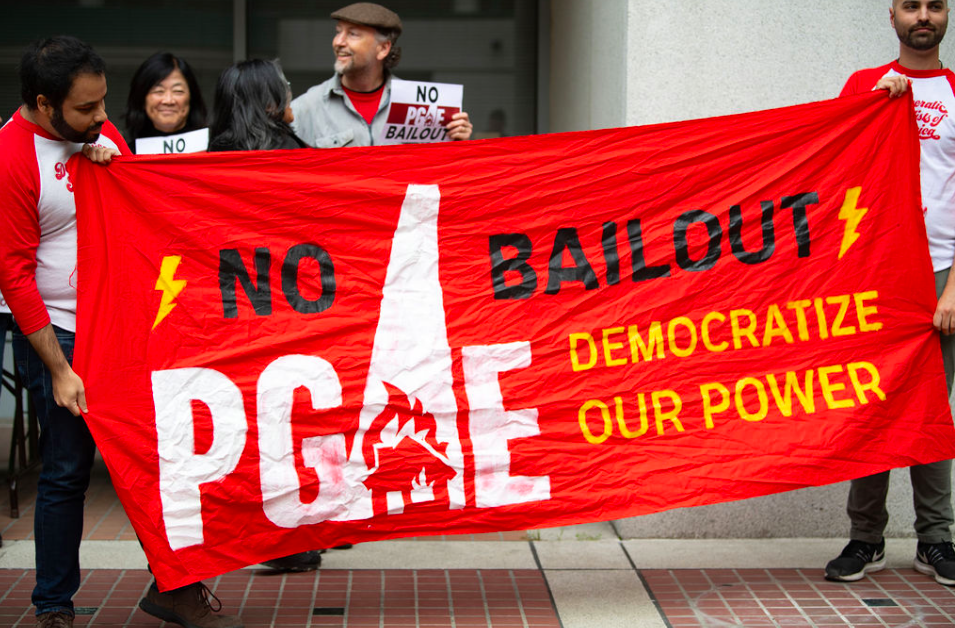The Sonoma County DA’s office filed criminal charges against PG&E this past week, the latest entry on the utility’s criminal rapsheet that seems longer than a California power line. PG&E stated that the company disagreed with the criminal charges and is “committed to making it right.”
The Reclaim Our Power grassroots organization responded with an emotional press conference Thursday, demanding that the California Public Utility Commission make things right by denying PG&E’s “safety certificate” on April 15th, a drastic step that would bring PG&E one step closer to having its entire business license revoked.

That, in turn, could lead the way to turning the grid over to public-power agencies.
“CPUC needs to do their job to hold this murderous utility accountable so we can feel safe again,” said Mari Rose Taruc of the Reclaim Our Power Utility Justice Campaign.
To whether the five CPUC commissioners should make the unprecedented decision to revoke the safety certificate, Taruc said, “Hell yes…what are you waiting for? Every fire season we don’t know if PG&E will set us on fire or shut off our electricity.”
Reclaim Our Power says PG&E crossed a fire line of criminal behavior some time ago, highlighted by the groups release of its “Failing Since Bankruptcy” Scorecard.
Another panelist, Jessica Tovar of Local Clean Energy Alliance, insisted that every ignored PG&E crisis was a wasted opportunity.
“We advocate local, clean energy. PG&E systems are old and have not been maintained. This is a great opportunity to rebuild the system to work for us. We could be producing energy locally, cleanly and putting our people to work.”
“We need a takeover not a makeover,” Tovar said. “They (PG&E) should not be allowed business as usual with the track record of a serial killer.”
Every reasonable definition of “infrastructure” includes gas lines and power lines, so the panel was cautiously optimistic about the possibilities of Biden’s “The Americans Jobs Plan.”
“President Biden and Vice President Harris have talked about their commitment to environmental justice,” Taruc said. “We have the local clean energy ideas, but we need more investment in local microgrids so if the power gets shut off, we still have the solar and batteries for our health clinics. It costs money for that kind of infrastructure, and we could use federal dollars to do that.”
Perhaps the most emotional of the presentations was the simple appeal from Jay Salazar of Power to Live, an SF Bay Area coalition formed in 2019 in response to life-threatening power shutoffs by PG&E.
“PG&E has shut off our power to protect their profits, and they have plans to increase shutoffs in 2021,” Salazar said. “Think about elders in your life, think about people who rely on insulin, breathing machines, medical equipment- are you willing to leave their lives to PG&E after all they’ve done? I’m not. It’s time to do something.”
Gabriela Orantes of the North Bay Organizing Project emphasized the social inequities that the fires and pandemic have uncovered. She reflected on her community around Santa Rosa.
“These compounding disasters demonstrate the resilience in our communities, but we should not be expected to live in this way,” Orantes said. “The property damage is always highlighted, but more important is the lives lost and the vulnerabilities exacerbated by the PG&E fires.
“What’s incredibly frustrating is our communities are forced to choose between work and wildfire smoke because we can’t lose our jobs. And then to face higher power bills on top of that….you destroy our communities and now you want us to pay for it?”
Tere Almaguer of PODER, a Latino immigrant group based in the Mission District that fights for social and environmental justice, said her community has been battling for justice against PG&E for some time.
“One of my earliest memories is fighting alongside activists like Marie Harrison against the pollution PG&E was spewing into Bayview Hunters Point.”
On a personal note, Almaguer shared that her household had never received a PG&E bill over $250. Last month, despite the fact her household had not changed any habits, the bill was $528.
“During a pandemic, when many of us don’t have steady work, I was appalled that PG&E would be willing to raise our rates to pay for their failures,” Almaguer said. “Not only are they spewing pollution into our neighborhoods, causing gas pipe explosions, causing fires, but they’re forcing us to pay for it.”
“There is no one really regulating them. They regulate themselves. I don’t know in what world that makes sense. CPUC please revoke their license. Let someone else create a grid good for the communities and the planet.”
Aniya Butler, an Oakland member of Youth vs. Apocalypse, read a prepared statement that read like poetry.
“I remember the Kincaid fire. I remember school being canceled. I saw people on ventilators having their power cut off.
“PG&E believes our lives are disposable,” Butler said. “This very idea that people are disposable is what created the climate crisis. We don’t need PG&E to make more promises they aren’t going to keep.”
Meanwhile, California is on the precipice of another drought as the sun’s free energy blazes down, turning trees to tinder and reducing snowpack that would help churn turbines for carbon-free energy via Spring run-off. Most experts expect another severe fire season. Will the same PG&E rise from the ashes yet again? When the CPUC makes its decision on PG&E’s safety certificate on April 15th, significant change could come to PG&E. Without significant change, business as usual means California will continue to rely on PG&E “to make things right.”




